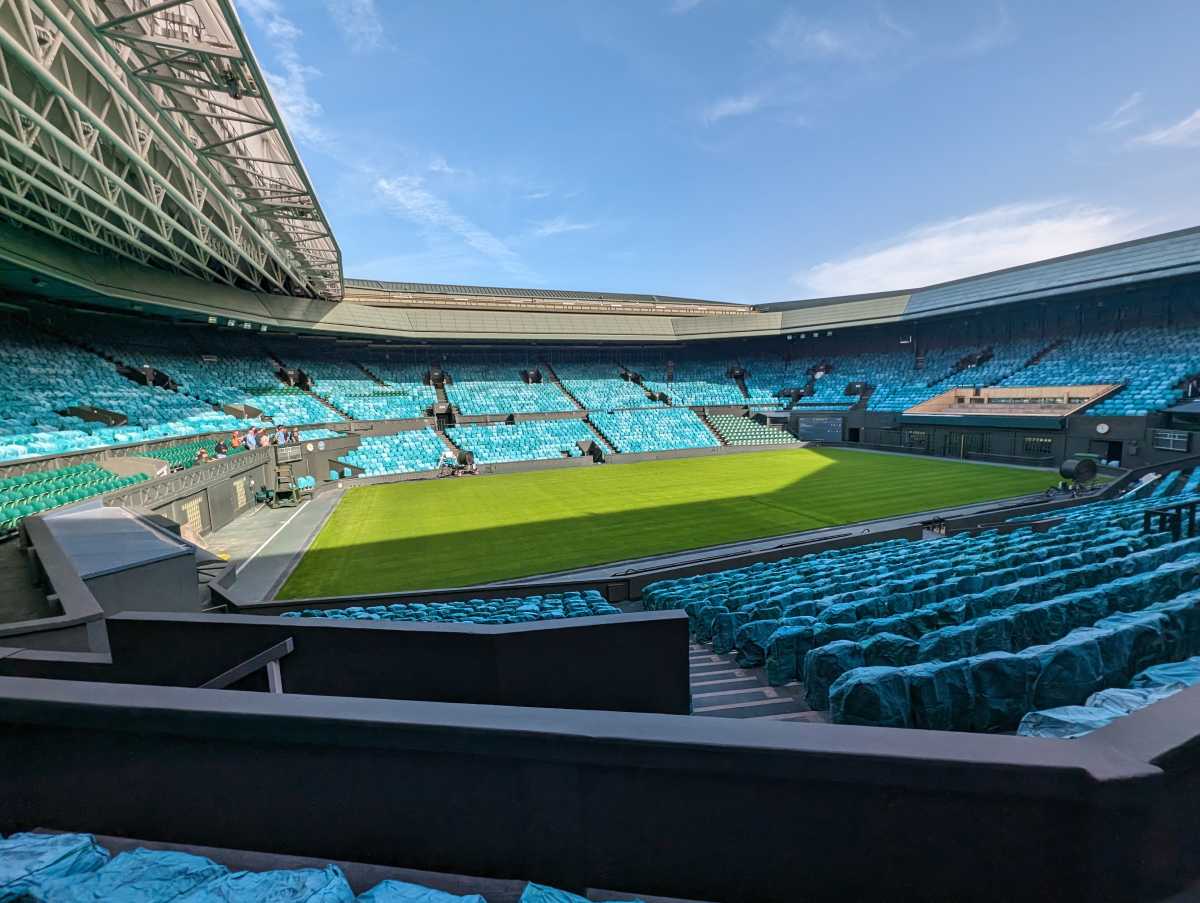If 2023 is the year of artificial intelligence, the Pixel 8 and 8 Pro shine brightest.
AI is used to optimize speed, capture and edit photographs, summarize webpages, screen calls, and even create customized backgrounds.
All of those capabilities are available on the ordinary Pixel 8, but many more are only available on the more costly Pixel 8 Pro. The lack of a 5x telephoto lens and an inferior ultrawide camera is unsurprising, but you’ll also have to make due with a worse display, a glossy finish, no temperature sensor, and some missing software functions.
Are those sacrifices worth it to save $300/£300? In the end, it comes down to what you’re looking for in a phone.
BUY PIXEL 8 FROM AMAZON NOW
Design & Build
- Compact yet premium design
- Glass back attracts dirt
- Lightweight, but still durable
Google handsets now have a distinct identity after years of tinkering with their design. Aside from more rounded sides, the Pixel 8 hasn’t altered much.
It means that the eye-catching camera visor still spans the whole top of the phone. I’m not a great fan of how it appears, but you can’t deny that it’s distinct. Camera modules remain one of the primary ways a phone differentiates itself from the competition, albeit you will have to deal with dirt building above and below the visor.
![]()
While both Pixel 8 phones feature glass backs, the ordinary model has a glossy surface as opposed to the matte one seen on the 8 Pro. Even just a few minutes of usage, the Hazel model began to display fingerprint smudges and other debris. I’d anticipate the Obsidian (black) and Rose (pink) variants, your only two options, to be considerably worse.
As a consequence, I’d suggest a case. The official Google version provides more grip and a beautiful dash of color, but it costs $34.99/£34.99 more. As is customary, there are several third-party options.
However, even without it, I wouldn’t be concerned about durability. Both the front and back of the phone are made of Gorilla Glass Victus, which has been certified to withstand drops of up to 2 meters and to be scratch resistant (albeit our Pixel 7 did break slightly on the corner while falling out of a car).
Maintaining great durability in such a lightweight, compact phone is impressive
The Pixel 8’s IP68 certification is comparable to that of other premium phones. It implies the gadget is completely dust-proof and can withstand a 30-minute submersion in up to 1.5m of water.
It’s remarkable that such a lightweight, tiny phone can be so durable. The Pixel 8 weights just 187g, which is a welcome departure from my normal Samsung Galaxy S23 Ultra (234g). It’s still not a one-handed phone, but very few smartphones are these days, and it’s smaller than the Pixel 7.
The luxury appearance and feel continues to the aluminum sides, however it took me a few days to get used to the tactile button location. The power button on the Pixel 8 is located above the volume controls, which is the reverse of what we see on other Android phones.
![]()
It implies the power button is awkwardly high on the right side, yet in order to turn the phone off, you must press and hold both it and the volume up button. When you do, you’ll realize how good the vibration motor is, allowing for excellent haptic feedback in a number of situations, including typing.
Screen & Speakers
- Excellent 6.2in, 120Hz OLED
- Upgraded face unlock
- Decent stereo speakers
The Pixel 8 is not a tiny phone, but it is quite modest by current standards. Google has actually lowered the display to 6.2in (from 6.3in), highlighting the contrast between it and the 6.7in Pixel 8 Pro.
On paper, the screen does not appear to be noteworthy. Although we’ve seen 10802400 OLED displays before, they still look amazing on the Pixel 8, giving rich, brilliant colors in the default ‘Adaptive’ setting. However, you can simply change this for the ‘Natural’ setting, which is gentler on the eyes – both look beautiful.
![]()
Whatever option you select, the great deep blacks we’ve come to expect with OLED are visible, especially with a systemwide dark mode enabled by default. A higher resolution would be good, but I didn’t see any difference; the Pixel 8’s screen has enough of detail, with all material looking clear and crisp.
The primary display improvement over the Pixel 7’s 90Hz refresh rate is the 120Hz refresh rate, which brings it in line with other premium phones. It’s a minor tweak in the broad scheme of things, but it makes everything feel a little more fluid and responsive.
You do, however, lose the Pixel 8 Pro’s LTPO technology, which allows the refresh rate to dynamically drop down to 1Hz depending on what you’re doing and helps to preserve battery life.
The Pixel 8’s screen offers plenty of detail, with all content looking clear and crisp
Instead, the Pixel 8’s ‘Smooth display’ toggle merely flips between 60- and 120Hz, with 60Hz being the sole customizable choice. As wonderful as a 120Hz display is, Google might have done a better job with its implementation.
But one thing I can’t complain about is the brightness. Using a SpyderX calibration tool, I measured a maximum of 950 nits, and vision is excellent in all conditions, even bright sunshine. And, as someone who dislikes curved screens, I’m delighted Google went with a flat version here.
An optical fingerprint sensor is built into the display and is straightforward to set up but painfully fickle. I enrolled the same finger four times to increase the likelihood of a quick unlock, but it still took many tries.
![]()
Instead, I’d recommend utilizing the improved face unlock. For the first time in a Pixel phone, it’s safe enough to be utilized for Google Wallet and mobile banking applications, courtesy of the Tensor G3 processor.
While not as smooth as Apple’s Face ID, a crucial advantage is that no notch or large pill-shaped cutout is required, only the standard punch-hole selfie camera. AI and ML (machine learning) are handling a lot of the heavy lifting in the background, and the extra second or two is well worth it for the added protection.
Stereo audio is supported by the Pixel 8, with sound coming from two downward-firing speakers and the earpiece. It has a surprising amount of punch for such a little phone, with good definition and excellent mid-range frequencies.
![]()
However, as feared, the bass and treble are both inadequate, necessitating the use of headphones for anything more than casual listening.
Specs & Performance
- Google Tensor G3 and 8GB RAM
- Very good performance
- Only 128- or 256GB of storage
One of the key additions in the Pixel 8 range is Google’s Tensor G3 processor, which is available on both phones. Its key selling point is its new AI capabilities, although speed is also critical.
I was apprehensive that the Pixel 8’s 8GB of RAM would make it seem slow, especially because the 8 Pro has 12GB, but I was wrong.
The Pixel 8’s performance isn’t nearly class-leading, but it still provides more than enough power for the great majority of consumers. My average day consists of a lot of chatting, web browsing, navigating, taking photographs, and watching videos. Even while flipping between them fast, the Pixel 8 didn’t grow visibly heated.
The Pixel 8 still offers more than enough power for the vast majority of people
I was particularly amazed by how effectively it handled demanding mobile games, with titles like Asphalt 9 and Call of Duty: Mobile operating without stuttering or frame drops. If you’re serious about gaming, I’d still prefer a specialized gaming phone.
When the Tensor G3 is combined with that 120Hz refresh rate, everything seems quite fluid and quick, but not as fast as Snapdragon 8 Gen 2 phones. The standards below reflect this, although it is not cause for alarm.
Google Pixel 8 benchmarks
Internal storage is limited to 128GB or 256GB, which is disappointing. With no microSD expansion and about 18GB used up by system files, it’s worth buying the extra $60/£60 for 256GB if you’re hesitant. It’s a shame that the 8 Pro’s 512GB and 1TB capacities are only available in the US.
However, there are only minor connectivity improvements, and Wi-Fi 7 and Bluetooth 5.3 are more about futureproofing than usability in 2023. And, of course, 5G is supported.
Cameras & Video
- Superb main and selfie cameras
- Decent 12Mp ultrawide
- No telephoto
- Various AI editing features
Cameras have always been the primary reason for purchasing a Pixel phone, and this is even more true with the Pixel 8.
The major reason for this is the 50Mp main sensor, which is similar to the Pixel 8 Pro and a slightly refined version of the 50Mp present on the Pixel 7. Along with Google’s amazing (possibly unrivaled) software processing, the Pixel 8 is unrivaled in point-and-shoot smartphone photography.
![]()
I tested the camera in a variety of circumstances and found no flaws. Detail, dynamic range, and exposure are all consistently outstanding, whether you’re photographing a large landscape or a close-up of a structure.
The picture processing isn’t realistic, but I believe the small increases in saturation and contrast correspond to how most people would alter them. If you don’t like what Google is doing here, you may always shoot in RAW and make your own personal adjustments.
Unfortunately, the 12Mp ultrawide lens is a major drop from the Pixel 8 Pro’s comparable 48Mp sensor. Images are visibly less detailed as a result, but because to the strong software processing, they’re still useable unless you zoom close. Colors and exposure are still extremely good.
The Pixel 8 can’t be beaten when it comes to point-and-shoot smartphone photography
Night Sight is available on both the primary and ultrawide lenses, and it excels at enhancing low-light images while preserving crucial details. It’s one of the best night modes I’ve ever used.
However, because the 48Mp telephoto lens is absent, there is no optical zoom, so you’ll have to rely on the digital version instead. Of course, it’s not quite as fantastic, but it does an excellent job of keeping details even at the maximum 8x.
When it comes to the front camera, though, there are no compromises. Despite having a low-resolution 10.5Mp camera, the Pixel 8 can take superb standard and ultrawide pictures. Detail and dynamic range are likewise great, and exposure is handled quite well.
The software also allows for great portrait photographs from both the primary and selfie cameras. Edge recognition is the finest I’ve seen on any smartphone, and subjects are sharp and well-lit. The dog image in the gallery below was a true ‘wow’ moment for me.





However, there are a plethora of advanced editing capabilities available after you’ve shot a photo or video. The most notable feature is Best take, which allows you to replace people’s actual faces in a group photo with one from another image taken about the same time. I agree with my colleague Hannah that it has a dystopian air to it, but I can’t deny how effectively it works and might be a book if you struggle to get family photos with everyone smiling at the same moment.
Then there’s Magic Editor, which lets you adjust the size and location of certain subjects in a shot, or remove them totally. This is more hit-or-miss, with the new background frequently seeming unrealistic. However, Magic Audio Eraser is outstanding in its ability to properly reduce annoying background sounds.
![]()
However, because the Video Boost function is specific to the Pixel 8 Pro, you won’t be able to benefit from the increased quality and Night Sight support. The Pixel 8’s footage (up to 4K at 60fps) is adequate, but much inferior to that of the iPhone.
Software & Features
- Runs Android 14
- Excellent user experience
- Seven years of updates
The Pixel 8 and 8 Pro are the first phones to ship with Android 14. Many more will receive the upgrade over time, but only Google phones will receive the’stock’ version. And after prolonged use, I completely see why Android on the Pixel is so well regarded.
In my opinion, the Pixel 8 offers the finest user experience of any smartphone. It’s smooth, clean, and intuitive, with everything in its proper position. This includes the always-on display, which is straightforward and easy to understand at a glance.
![]()
I also love the rounded app icons and fast settings buttons, and themes and wallpapers may offer a great burst of color. The latter even enables generative AI, allowing you to design a wallpaper that is entirely unique to you.
Call screening is still a Pixel-only function, and it’s a convenient method to filter out spam calls or fast get a notification (such as a shipment arriving) without answering. I really like the Now Playing feature, which detects music that are playing around you – even when you’re not connected to the internet.
In my opinion, the user experience on the Pixel 8 is the best you’ll find on any smartphone
The additional accessibility features, an enhanced share sheet, and the option to utilize the flash as a notification light are all excellent additions to Android 14.
However, Google’s dedication to software support is amazing. The Pixel 8 will receive seven years of Android and security upgrades, pushing it all the way up to Android 21 in 2030, according to the firm.
That’s the best of any Android phone manufacturer, and a significant increase over the Pixel 7’s three years of Android upgrades and five years of security patches, as well as Samsung’s previous leading OS upgrade pledge of four years – we only hope Google honors its word.
Battery Life & Charging
- 4575mAh battery
- Underwhelming battery life
- Only 27W charging
The Pixel 8’s battery life is without a doubt the most disappointing aspect of the device. That says something about the phone’s quality, as it won’t be a dealbreaker for many people, but I was hoping for more.
The phone features a 4575mAh battery, which is greater than the Pixel 7 (4355mAh) but substantially smaller than the Pixel 8 Pro (5050mAh). You can get a full day of battery life on a single charge, but only if you’re ready to put up with power anxiety or use energy conservation mode near the end of the day.
![]()
When you’re using mobile data, location services, and a high screen brightness for several hours, you’ll need to find a power source as nighttime approaches. A battery test score of 10 hours and 49 minutes is respectable, but it does not reflect my real-world experience.
I believe there are several variables at work here. The first is a battery capacity that is most likely insufficient to support such a strong, brilliant phone. Another feature is the high refresh rate display, as well as the Tensor G3 processor.
Given that Android 14 was only recently launched at the time of writing, it may be some time before the software is optimized to provide the optimum battery life.
Battery life is undoubtedly the most disappointing thing about the Pixel 8
Unfortunately, charging isn’t any better. The Pixel 8 is restricted to 27W of power, and there is no charger provided, only a cord.
Using an existing 65W charger, the phone reached 23% in 15 minutes and 44% in half an hour, with a full charge taking about 85 minutes. Some contemporary phones charge nearly three times faster.
You receive 18W Qi wireless charging at the very least, as well as slower reverse wireless charging for any other phone that supports the Qi standard.
Price & Availability
The Pixel 8 is $100/£100 more expensive than its predecessor, the Pixel 7. The new starting price of $699/£699 gets you the 128GB device I tested, but upgrading to 256GB costs $759/£759.
You may get one from a variety of merchants in the United States and the United Kingdom, including the Google Store and Amazon.
Should you buy the Google Pixel 8?
That is entirely dependent on your search criteria. The Pixel 8 is an excellent smartphone, but it is not for everyone.
Excellent primary and selfie cameras solidify its status as one of the best photography phones available, especially when paired with Google’s superior software. However, you lose the Pixel 8 Pro’s 5x telephoto sensor, and the ultrawide sensor is a significant step down.
The Tensor G3 processor from Google is a nice surprise, providing exceptional performance in practically every case. However, it is not as quick as Qualcomm’s flagship Snapdragon 8 Gen 2 processor.
With the great Android 14 and a remarkable seven years of OS and security upgrades, there are no software drawbacks. However, the combination of poor battery life and delayed charging holds it back a little.
And, with so many capabilities now available only on the Pixel 8 Pro, the standard device is becoming less tempting. It’s still worth considering, but only if you value a small footprint and excellent software.
Specs
- 6.2in QHD+ 120Hz LTPO OLED display
- Google Tensor G3 chipset
- 8GB RAM
- 128/256GB non-expandable UFS 3.1 storage
- 4575mAh battery
- 27W wired charging
- 18W wireless charging
- 4.5W reverse wireless charging
- 50Mp f/1.68 main camera
- 12Mp f/2.2 ultrawide camera
- 10.5Mp f/2.2 front camera
- 5G
- Wi-Fi 7
- Bluetooth 5.3
- IP68
- Gorilla Glass Victus
- 150.5mm x 70.8mm x 8.9mm
- 187g

